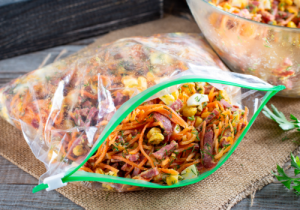Tips and Tricks on Food Preservation to Avoid Waste
Food waste sometimes results from poor food management. The storage and preservation method differs depending on the food’s nature. Below, you will discover the best practices for keeping fresh foods and prepared dishes, whether in the refrigerator or in the freezer.

Refrigeration:
Upon your return from the grocery store, food should be refrigerated as soon as possible. Each food has a distinct preservation method and time. To help you figure it out, we prepared a summary table of the preservation methods for each food.

Freezing tricks
- Try recreating a vacuum packaging (airless) as well as possible; for example, suck the air out of a bag using a straw.
- Use strong aluminum foil to wrap foods that you plan to keep for three weeks or more.
- Use plastic bags made specifically for freezing, or which fastener will allow a hermetic seal for foods that you want to keep for a longer period.
Avoid regular plastic wrap: it loses its airtightness when exposed to the cold.
Foods that don’t preserve well when frozen:
- Lettuce: Thawed lettuce will be bland and softened.
- Tomato, bell pepper and chili pepper: these foods will lose their crunchy texture. They can be used in cooked dishes.
- Eggs: The raw egg shell will crack in the freezer. Cooked, it will get a hard, rubbery texture. Beaten eggs can be frozen.
- Spicy foods: seasonings get more or less spicy during freezing. It is better to season them after they are thawed.
Fruits and vegetables freezing – in detail:

Seasonally, fruits and vegetables can be abundant. Whether during summer harvests or when the purchase price is really advantageous, freezing is a good way to preserve fruits and vegetables that you have in large quantities. However, in order for foods to keep their flavour and nutritional intake, they must be prepared according to certain standards. We developed two tables showing the preparation methods for a number of fruits and vegetables.


8 Tips for Solo Cooking
8 Tips for Solo Cooking When living alone, cooking is not always super fun. Motivation is sometimes lacking, as well as inspiration. Moreover, it is a proven fact that the food distribution mode is often less favourable for people living alone than for families....
How to Cook with your Children
How to Cook with your Children Involving your children in the kitchen not only allows you to teach them practical skills such as cooking and food preparation, it also contributes to reduce food waste. Cooking with your children is an opportunity to share...
How to Start a Collective Kitchen within your Community Organization?
How to Start a Collective Kitchen within your Community Organization?A collective kitchen is a place where people can come together to prepare meals and share recipes. For your organization, it’s a great way to build relationships and create a sense of community, but...
To
contact us
Phone
418 763-7707 ext.7
Fax
418 763-7767
Address
50 1e rue Ouest, Sainte-Anne-des-Monts
(QC) G4V 2G5
tcsagim@hotmail.com



